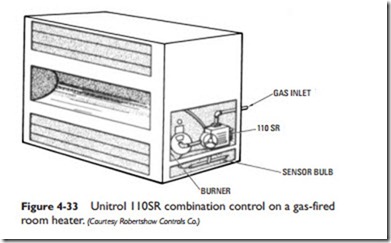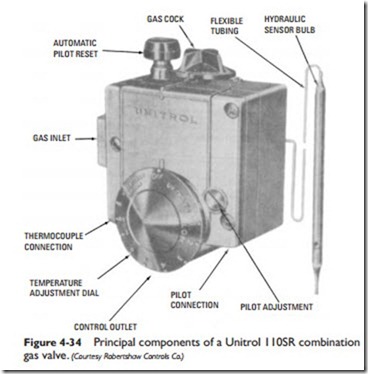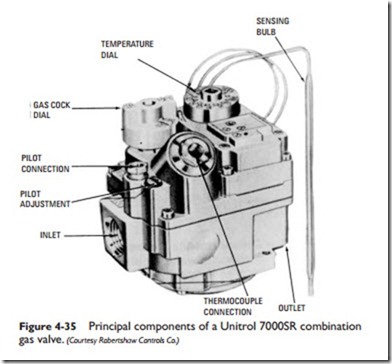Boiler Thermostats
A boiler thermostat is a safety control device installed inside a hydronic boiler. Its function is to limit the temperature of the hot water produced by the boiler. When the water temperature reaches a preset maximum limit, the thermostat switches off the burner and boiler. The target temperature can be permanently fixed or adjusted by the user.
Remote-Bulb Thermostats
A remote-bulb thermost at is distinguished from other thermostats by having a sensing element (usually enclosed in a bulb-type device) located at some distance from the thermostat controller body.
In residential heating and/or cooling applications, remote-bulb thermostats are used for space temperature control of room and vented-recess heaters, room air-conditioning units, or radiator valves. Outdoor thermostats also operate on the remote-bulb principle.
Sometimes these thermostats are combined with other controls to provide a number of different control functions in one package. Two examples of this thermostatic combination control are the Robertshaw Unitrol 110SR and 7000SR controls.
The Unitrol 110SR is used as a combination control for small gas-fired room heaters (see Figure 4-33). The control contains a thermostatic valve, a sensing bulb, temperature (thermostat) dial, gas cock, automatic pilot valve, and a pressure regulator (see Figure 4-34).
The sensing bulb is located in the return air stream at the bottom of the heater. The temperature of the return air is sensed and the valve is actuated to open and close by the hydraulic system in the control. The gas cock and automatic pilot mechanism provide safe lighting of the heater. If the pilot light should go out, the main gas and pilot gas supplies are shut off by the automatic pilot valve. Main burner gas pressure regulation is provided by the pressure regulator incorporated in the Unitrol 110SR control.
Figure 4-35 illustrates the principal components of a Unitrol 7000SR control. This is a diaphragm valve that operates through the center of a thermostatic bleed valve in an internal bleed line. The Unitrol 7000SR combines into a single package a diaphragm valve, thermostat valve, temperature (thermostat) dial, gas cock, automatic pilot valve, and a pressure regulator.
Application of a Unitrol 7000SR on a gas-fired vented-recess heater is illustrated in Figure 4-36. The sensing bulb is placed in the return air opening at the bottom of the furnace.
Both the Unitrol 110SR and Unitrol 7000SR thermostatic space heater controls use a closed hydraulic sensing and actuating device consisting of a bulb, capillary tube, and a bellows or diastat.
The cross section of a typical hydraulic sensor and actuator is illustrated in Figure 4-37. The bulb, capillary tube, and actuator are filled with a liquid that has a high coefficient of expansion. When the bulb senses a rise in temperature, it causes the volume of the liquid to expand. This expansion is transferred through the capillary tube to expand the hydraulic bellows. The bellows is spring-loaded to oper- ate a snap mechanism to a valve open condition (see Figure 4-38). As the temperature rises, the expansion of the liquid opposes the spring-loading to secure a valve closed (i.e., off) condition when the required temperature is reached.


